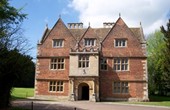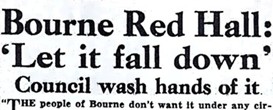 |
 |
Why our historic buildings are at risk
by REX NEEDLE
|
The public debate over the future of our Town Hall is a reminder that many of our historic buildings are currently at risk through the inaction of our local councils and other organisations into whose care they have been delegated. The parish of Bourne has 71 listed buildings which have been photographed and described in detail in my book Bourne Conservation Area (2002), a copy of which is on display at the Heritage Centre in South Street and is also a source of reference for Bourne Preservation Trust. Fortunately, most of these buildings are in private ownership and useful occupation which ensures their future whereas the evidence indicates that several of the most important ones which are administered by local authorities and institutions are at risk and may not survive if the current policy of neglect continues. We have a prime example of this uncaring attitude from sixty years ago when, if the wishes of our local authorities had been realised, the Red Hall would be no more. This fine building dating from 1605 had several owners before being sold in 1860 to the Bourne and Essendine Railway Company for use as the stationmasterís house and ticket office, a role which continued for the next 100 years but when the line closed it became redundant and in 1955 councillors at town, district and county level decided that Bourne did not want it and that the building should be left to fall down. Worse was to follow because in 1957 a demolition order was issued but mercifully this was postponed to give time for a new owner to be found and in 1962 wiser counsel prevailed when Bourne United Charities acquired the freehold and saved it from destruction. The total cost of restoration was estimated at £35,000 [£670,000 at todayís values] and the donors included the Pilgrim Trust at Boston (£2,000), the Department of the Environment (£5,000), Kesteven County Council (£800), Bourne Urban District Council (£1,300), South Kesteven Rural District Council (£1,000) with the balance being contributed by the people of Bourne through various donations and fund raising schemes. This money to pay for the work was raised on the understanding that the building would be turned into a museum and community centre for the public benefit but this promise has not been fulfilled. In fact, despite being Grade II listed, the Red Hall is rarely open to visitors and remains closed to all except the office staff who work there and the trustees who meet there occasionally although some rooms are hired out for public functions at a fee. Then we have the cemetery chapel in South Road which was given a Grade II listing in 2007 by the Department of Culture, Media and Sport (DCMS) to save it from demolition by the town council. The Bourne Preservation Trust was promised the key of the door to restore and preserve it for future use but after six years of obfuscation and delay this has yet to happen and the Victorian building now stands empty and neglected. Another Grade II public building, Wake House in North Street, has been waiting in the wings and slowly deteriorating for over six years while another local authority, this time South Kesteven District Council, procrastinates over handing it to the Bourne Arts and Community Trust which has been in residence since 1997 and now provides a home for some 40 local organisations yet has no lease to enable it carry out repairs and maintenance. One of our oldest buildings, the Old Grammar School in the churchyard which dates from the 17th century, is also Grade II listed but has been left to deteriorate since it was closed to the public and condemned as being unsafe in April 2003 but two years later the property was put up for sale although there has been no buyer. The school is administered by Bourne Educational Foundation and last year Bourne Preservation Trust announced its intention to take over the building and turn it into a centre for heritage excellence for the benefit of townspeople and of visitors but progress has been slow and work on this ambitious project has yet to begin. The current scenario with our Town Hall has a similar resonance because Lincolnshire County Council no longer wants the building and wishes to be rid of it at all costs while the public consultation is regarded by many as a bureaucratic method of smoothing over this process of rejection whereas a more democratic way forward would be to re-open it for its former use as home of the town council with space for additional facilities. The public consultation is therefore no such thing because the county council is merely offering options supporting a decision that has already been taken to get rid of the building rather than giving a choice for its continued use while remaining under their control. As a result, the people not only have to decide what the Town Hallís future role may be but will also have to find the money to pay for it from charitable or grant sources even though it was bought mainly by public subscription in the first place. Another factor in the future of the Town Hall will be the inevitable delay such as that being experienced with the other public buildings described here. The wheels of bureaucracy grind exceedingly slowly and even the most complicated process that could be completed in weeks will inevitably take months and often years. We are witnessing this already because the public consultation over the future of the Town Hall was originally due to finish on November 11th but this has now been extended to the end of the year. After that the committee work begins and so there will be opportunities for further delays before its new role is announced and implemented and then the fund-raising will begin. If the examples I have outlined are a reasonable guide, then five years would seem to be a modest estimate of the time which may elapse before we see a public footfall within the walls of this Grade II listed building during which time it will continue to deteriorate and the people despair. |